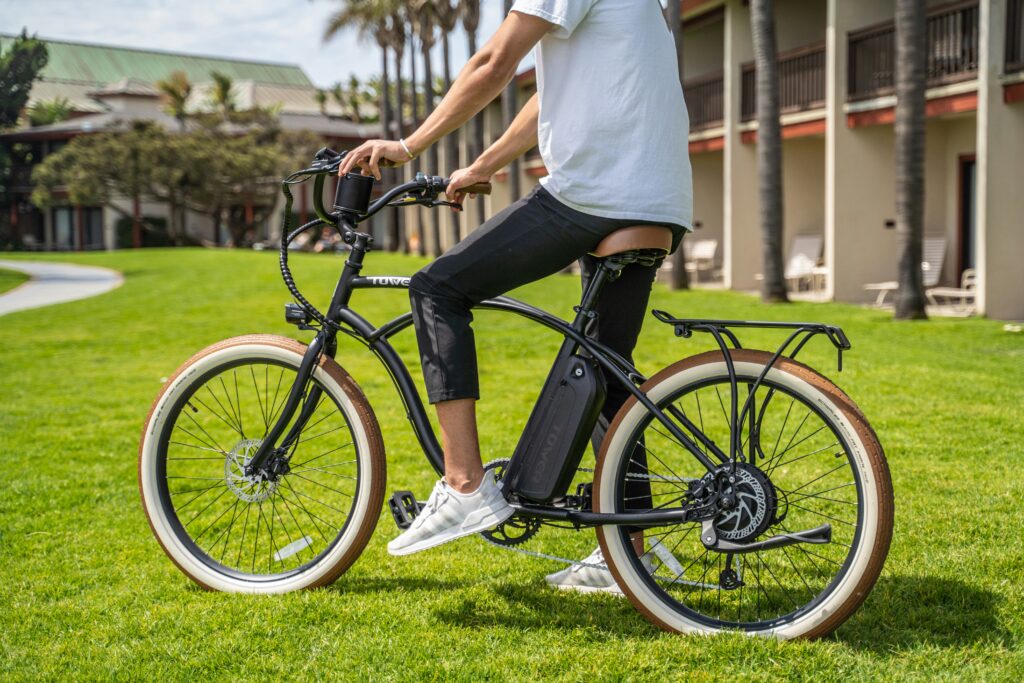So you’ve got a regular old bike sitting in your garage and you’ve been wondering how you can give it a little boost? Well, look no further because we’ve got the answer for you! In this article, we’ll show you exactly how to turn your ordinary bike into an electric ride. Say goodbye to those tiring uphill climbs and hello to effortless cruising, all while enjoying the fresh air and feeling the wind in your hair. Get ready to embark on an electrifying adventure as we guide you through the simple steps of making your bike electric.
Choosing the Right Bike
When it comes to making a bike electric, one of the first steps is choosing the right bike for the conversion. You want a bike that is suitable for the type of riding you plan to do and can handle the additional weight of the electric components.
Identifying the Bike Type
Start by identifying the type of bike that would best suit your needs. Are you looking for a mountain bike to tackle off-road trails or a road bike for commuting? Knowing the type of bike you want will help narrow down your options and make the conversion process smoother.
Considering the Bike Frame
The bike frame is an important factor to consider as it determines the overall strength and stability of your electric bike. Look for a frame that is made of durable material, such as aluminum or steel, and has sufficient clearance for mounting the conversion kit components.
Checking the Weight Capacity
Since you’ll be adding electric components to your bike, it’s crucial to check the weight capacity of the frame and other parts. The additional weight of the motor, battery, and controller should not exceed the recommended weight limit of the bike to ensure safe and optimal performance.
Evaluating the Wheel Size
Another consideration when choosing a bike for conversion is the wheel size. Electric bikes come in various wheel sizes, and each offers a different riding experience. Smaller wheels provide quicker acceleration, while larger wheels offer better stability and traction. Consider your riding style and terrain to determine the wheel size that suits you best.
Determining the Conversion Kit Type
Once you’ve selected the right bike for your electric conversion, it’s time to choose the conversion kit that will transform your regular bike into an electric one. There are different types of conversion kits available, and each has its own advantages and considerations.
Direct Drive Conversion Kit
A direct drive conversion kit is a popular choice for electric bike enthusiasts. It consists of a hub motor that is directly integrated into the rear wheel. This type of conversion kit offers excellent torque and is suitable for riders who prioritize power and reliability. However, it can add weight to your bike and may require modifications to the frame.
Geared Conversion Kit
If you’re looking for a lighter and more efficient option, a geared conversion kit might be the right choice for you. This kit features a smaller, lighter motor that is connected to the bike’s drivetrain using a set of gears. Geared conversion kits offer a smoother and more natural pedaling experience, making them ideal for daily commuting or longer rides.
Mid Drive Conversion Kit
For those seeking a more integrated and balanced electric bike, a mid drive conversion kit is worth considering. This type of kit replaces the bike’s bottom bracket and utilizes the existing gears to drive the motor. Mid drive conversion kits offer excellent hill-climbing abilities and a well-balanced weight distribution, making them great for riders who tackle varied terrains.

Gathering the Necessary Tools and Materials
To successfully complete the electric bike conversion, you’ll need a range of tools and materials. These items will help you install the conversion kit and ensure a secure and reliable setup. Let’s take a look at what you’ll need:
Electric Conversion Kit
The core component of your electric bike conversion is the electric conversion kit itself. This kit typically includes the motor, controller, throttle, and any additional accessories required for the installation. Make sure to choose a conversion kit that is compatible with your bike’s specifications and your riding preferences.
Battery Pack and Charger
An electric bike relies on a battery pack to power the motor and other electrical components. When choosing a battery pack, consider factors such as capacity, voltage, and compatibility with your conversion kit. Additionally, don’t forget to invest in a reliable charger that matches your battery pack specifications to ensure safe and efficient charging.
Wrenches and Screwdrivers
Various wrenches and screwdrivers are needed to disassemble and reassemble the bike during the conversion process. Make sure you have a set of wrenches of different sizes to fit the different bolts and nuts on your bike. Screwdrivers, both Phillips and flathead, will also come in handy for loosening and tightening screws.
Electrical Tape and Zip Ties
These are essential for securing and organizing the cables and wires during the conversion. Electrical tape is great for insulating and protecting exposed wires, while zip ties can be used to bundle and secure cables together. Having these tools on hand will make it easier to maintain a neat and organized wiring setup.
Preparing the Bike
Before installing the conversion kit, it’s important to prepare your bike for the conversion. This involves removing certain components, cleaning the frame, and making necessary adjustments to ensure a smooth installation process.
Removing Components
To create space for the conversion kit, you’ll need to remove certain components from your bike. These may include the rear wheel, derailleur, chain, and any unnecessary attachments or accessories. Follow the manufacturer’s instructions or consult a bike mechanic if you’re unsure about removing specific components.
Cleaning the Frame
Once you’ve removed the necessary components, take the opportunity to thoroughly clean the frame. Use a mild detergent and water to remove any dirt, grime, or grease that may have accumulated on the frame. This will ensure better adhesion for any cable management or protective components you’ll be installing.
Installing Cable Management
To maintain a clean and organized appearance, it’s important to install cable management solutions. These can include cable clips, zip tie mounts, or adhesive cable holders. Securing the cables and wires to the frame will prevent them from getting tangled or interfering with the bike’s operation.
Protecting Components
When converting your bike to electric, it’s a good idea to protect certain components from the elements. This can be achieved by applying a protective coating, such as clear frame protectors or corrosion-resistant sprays, to vulnerable areas of the bike. By taking these precautions, you can extend the lifespan of your electric bike.

Installing the Conversion Kit
Now that your bike is prepared, it’s time to install the conversion kit. This step-by-step process will guide you through attaching the motor, controller, throttle, and battery pack to your bike.
Removing the Rear Wheel
Begin by removing the rear wheel from your bike. This will allow you to access the dropouts and mount the motor hub. Follow the manufacturer’s instructions for removing the wheel, and keep track of any washers or spacers that may be needed for reinstallation.
Attaching the Motor and Controller
Once the rear wheel is removed, install the motor hub by sliding it into the dropouts. Make sure it is aligned properly with the fork and that the cables are facing the desired direction. Secure the motor to the frame using the appropriate nuts or bolts. Next, connect the controller to the motor and ensure all the electrical connections are secure.
Connecting the Throttle and Brakes
You’ll need to connect the throttle to the handlebars and the brake levers to the controller. Follow the instructions provided with your conversion kit to properly install and secure these components. Ensuring proper connections between the throttle, brake levers, and controller will enable you to control the motor and electric assistance effectively.
Mounting the Battery Pack
The final step in installing the conversion kit is mounting the battery pack. This can be done in various locations on your bike, depending on the frame design and your preference. Common mounting options include the down tube, rear rack, or inside a frame bag. Ensure the battery pack is securely fastened and won’t interfere with the bike’s operation or balance.
Connecting the Electrical Components
With the conversion kit installed, it’s time to connect the electrical components. This involves wiring the motor and controller, connecting the throttle and brakes, attaching the battery pack, and securing all the cables.
Wiring the Motor and Controller
Follow the wiring diagram provided with your conversion kit to connect the motor and controller correctly. Make sure to securely fasten the electrical connections by using electrical tape or heat shrink tubing. Take extra care to avoid loose or exposed wires that could potentially cause electrical shorts or malfunctions.
Connecting the Throttle and Brakes
Next, connect the throttle to the controller according to the provided instructions. Ensure a secure connection and position the throttle for easy access and comfortable operation. Additionally, connect the brake levers to the controller to enable motor cutoff when the brakes are engaged. Double-check that all the connections are properly tightened and secure.
Attaching the Battery Pack
Once the electrical connections are in place, attach the battery pack to the designated location on your bike. Follow the manufacturer’s instructions for proper battery installation, ensuring a secure and stable attachment. Make sure all the electrical connections between the battery pack and conversion kit are properly secured and the cables are neatly organized.
Securing the Cables
To maintain a clean and organized appearance, secure the cables using zip ties or other cable management solutions. This not only prevents cables from getting tangled or interfering with the bike’s operation but also provides a professional finish to your electric bike conversion.
Testing the Electric Bike
After the conversion kit and electrical components are installed and connected, it’s important to test the electric bike to ensure everything is functioning correctly and safely.
Checking the Motor Performance
Take your electric bike for a test ride to evaluate the motor performance. Pay attention to how smoothly the motor assists you while pedaling and how responsive it is to changes in speed or incline. If you notice any issues or inconsistencies, consult the conversion kit’s troubleshooting guide or seek assistance from the manufacturer.
Testing the Electronic Components
During the test ride, assess the performance of other electronic components, such as the throttle, brakes, and controller. Ensure that the throttle responds accurately and smoothly, and that the brakes engage and disengage the motor as intended. If you encounter any issues, fine-tune the settings or consult the manufacturer’s recommendations.
Evaluating the Battery Life
One of the crucial aspects of an electric bike is the battery life. Take note of how long the battery lasts under different riding conditions and settings. Keep in mind that factors such as terrain, rider weight, and assistance level can affect battery life. Based on your observations, adjust your riding habits or consider investing in a higher-capacity battery if needed.
Ensuring Safe Operation
Throughout the testing phase, prioritize your safety and that of others. Pay attention to how the electric components interact with your riding style and road conditions. Ensure that the motor assistance is smooth and consistent, that the brakes are responsive, and that all the electrical connections remain secure. If you encounter any safety concerns, address them promptly before embarking on longer rides or more challenging routes.
Adjusting and Fine-tuning
Even after successfully converting your bike to electric, there may be adjustments and fine-tuning required to optimize your riding experience and the performance of your electric bike.
Brake and Gear Adjustments
Fine-tuning the brakes and gears is essential to ensure smooth shifting and reliable stopping power. Adjust the brake pads to achieve optimal contact with the rims or rotors, and ensure the gears shift smoothly and accurately. If you’re unsure how to adjust these components, consult a bike mechanic or refer to instructional resources.
Balancing the Weight Distribution
Electric bike conversions can add significant weight to your bike, impacting its balance and handling. Experiment with different positioning of the battery pack or other components to achieve a balanced weight distribution. This will help maintain stability and control when riding the electric bike.
Testing the Bike’s Handling
Take your electric bike for a few test rides to evaluate its handling and overall performance. Pay attention to how it accelerates, turns, and handles different terrain. If needed, make minor adjustments to the bike, such as saddle height or handlebar position, to enhance comfort and control.
Making Necessary Modifications
As you gain more experience riding your electric bike, you may identify areas for improvement or personal preferences that require modifications. This could be anything from changing the handlebar grips to upgrading certain components. Stay open to making these modifications to tailor your electric bike to your specific needs and preferences.

Safety Considerations
When it comes to riding an electric bike, safety should always be a top priority. Here are some important safety considerations to keep in mind:
Wearing Proper Safety Gear
Always wear a properly fitted helmet to protect your head in the case of a fall or accident. Additionally, consider wearing gloves, knee and elbow pads, and reflective clothing for increased visibility. Dress appropriately for the weather conditions and ensure that your clothing does not interfere with the operation of the bike or its components.
Using Reliable Electrical Components
To ensure a safe and reliable electric bike, it’s crucial to invest in high-quality electrical components from reputable manufacturers. Choose a conversion kit that meets recognized safety standards and has positive customer reviews. A reliable conversion kit will not only provide a better riding experience but also reduce the risk of electrical malfunctions or accidents.
Understanding Local Laws and Regulations
Before taking your electric bike out on public roads or trails, familiarize yourself with the local laws and regulations regarding electric bikes. Different regions may have specific requirements regarding speed limits, bike paths, and licensing for electric bikes. Adhering to these laws and regulations will help you avoid fines and ensure a positive relationship between electric bike riders and other road users.
Ensuring Regular Maintenance
As with any type of bike, regular maintenance is essential to keep your electric bike in optimal condition. This includes checking tire pressure, inspecting brakes and gears, and lubricating the chain regularly. Follow the manufacturer’s maintenance guidelines and consult a bike mechanic for any complex or technical maintenance tasks. Regular maintenance will not only extend the lifespan of your electric bike but also enhance safety and performance.
Enjoying Your Electric Bike
Now that you’ve successfully converted your bike to electric and considered all the necessary safety considerations, it’s time to enjoy the benefits of your new electric bike!
Learning How to Operate the Electric Components
Take the time to familiarize yourself with how the electric components of your bike operate. Understand how the throttle works, how to adjust the level of motor assistance, and how to monitor battery levels. Learning these functions will help you make the most of your electric bike and optimize its performance.
Exploring Different Riding Modes
Most electric bikes offer various riding modes, such as pedal-assist or throttle-only. Experiment with these different modes to find the one that suits your needs and preferences. Pedal-assist mode can provide a more natural biking experience, while throttle-only mode offers effortless cruising. Enjoy the flexibility and versatility that electric bikes offer.
Understanding Battery Charging
To ensure a continuous and enjoyable ride, it’s important to understand how to properly charge your electric bike’s battery. Follow the manufacturer’s guidelines for charging, including the recommended charging time and frequency. Avoid overcharging or storing the battery at low levels for extended periods, as this can affect its lifespan and overall performance.
Going on Exciting Adventures
With your electric bike ready to roll, it’s time to embark on exciting biking adventures. Explore new trails, take longer rides, and experience the thrill of electric-assisted biking. Enjoy the freedom, convenience, and eco-friendly nature of your electric bike as you venture into new territories and discover the joy of riding with electric assistance. Happy riding!


